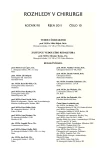Clinical Outcomes of Surgical Management of Acromioclavicular Dislocation with and without Ligament Suturing
Authors:
S. Kazda; L. Paša *; V. Pokorný *
Authors‘ workplace:
Klinika traumatologie, Úrazová nemocnice Brno, přednosta: prof. MUDr. Miloš Janeček, CSc.
; Klinika úrazové chirurgie, FN Brno, přednosta: doc. MUDr. Michal Mašek, CSc.
Published in:
Rozhl. Chir., 2011, roč. 90, č. 10, s. 561-564.
Category:
Monothematic special - Original
Overview
Introduction:
The aim of the study was to present a retrospective assessment of clinical outcomes of acromioclavicular (AC) dislocation surgery with and without suturing of the coracoclavicular ligament (CC).
Material and Methods:
Patients regardless of their age and gender were included in the study. All the subjects were operated by the same surgeon using the same surgical technique – traction cerclage. Every odd-numbered patient’s procedure included ligament suturing and every even-numbered patient was operated without ligament suturing. The patients underwent clinical follow up at identical time intervals, had Pruban (elastic net bandage) fixation applied for one week and had the same rehabilitation regime for 6 weeks. The wires were extracted at 6–8 months.
A total of 42 patients were included in the study. All the subjects were classified according to Tossy III, based on x-ray findings. The study group included 36 males and 6 females. The average age was 31.8 years (17–55). In 14 cases, preoperative stress x-rays of the upper extremity were performed.
CC ligmanet suture was completed in 21 patients and 21 patients underwent procedures without CC suturing. The clinical outcome was assessed after wire extraction.
Results:
Painful complications were recorded in 2 subjects and they reported the pain to be intermittent. The pain was classified as maximum grade 4, based on VAS (Visual analogue score). In one patient, the authors recorded pain sensation in the area of Kirschner’s wires endings. In this particular patient, the wires were extracted 6 weeks after the procedure and following that, the patient was symptom-free.
Conclusion:
Based on the findings, the authors recorded no differences in the clinical outcomes of AC surgery with or without CC ligament suturing.
Key words:
acromioclavicular dislocation – retrospective study – surgery
Sources
1. Keřkovský, M., Šprlákova-Puková, A., Uher, T., Vojtaník, P., Rouchal, M. Význam UZ vyšetření v diagnostice poranění ramenního kloubu. Acta Chir. orthop. Traum. čech., 2008; 75–73: 167–172.
2. Musil, D., Sadovský, P., Stehlík, J., Filip, L., Vodička, Z. Artroskopický kapsulární release u syndromu zmrzlého ramene. Acta Chir. orthop. Traum. čech., 2009;76–72: 98–103.
3. Tibore, J., Sellers, R., Tonino, P. Strength testing after third-degree acromioclavicularis dislocations. Amer. J. sport. Med., 1992; 3: 328–331.
4. Zeman, M., Rehák, M. Výsledky léčení akromioklavikulární luxace. Rozhl. Chir., 1979; 3: 175–178.
5. Bartoníček, J., Jehlička, D., Bezvoda, Z. Operační léčba akromioklavikulární luxace. Acta Chir. orthop. Traum. čech., 1988; 5–4: 289–309.
6. Foster, G. T., Chetty, K. G., Mahutte, K., et al. Hemoptysis due to migration of a fractured Kirschner wire. Chest, 2001; 4: 1285–1286.
7. Regel, J. P., Pospiech, J., Aalders, T. A., et al. Intraspinal migration of a Kirschner wire 3 months after clavicular fracture fixation. Neurosurg. Rev. 2002; 4: 110–112.
8. De Palma, A. F. Surgery of shoulder. J. B. Lippincott Company, 1973; 2: 314–328.
9. Galpin, R. D., Hawkins, R. J., Grainger, R. W. Comparative analysis versus nonoperative treatment of grade III acromioclavicular separations. Clin. Orthop., 1985; 193: 150–155.
10. Larsen, E., Bjerg-Nielsen, A., Christensen, P. Konservative or surgical treatment of acromioclavicular dislocation. J. Bone Jt. Surg., 1986; A-68: 552–555.
11. MacDonald, P. B., Alexander, M. J., Frejuk, J., Johnson, G. E. Comprehensive functional analysis of shoulder following complete acromioclavicular separation. Amer. J. sport. Med. 1988; 16: 475–480.
12. Mazocca, A. D., Arciero, R. A., Bios, J. Evaluation and treatment of acromioclavicular joint injuries. Amer. J. sport. Med., 2007; 2: 316–329.
13. Fraser-Moodie, J. A., Shortt, N. L., Robins, C. M. Injuries to the acromioclavicular joint. J. Bone Jt. Surg., 2008; B-90: 697–707.
14. Tossy, J. D., Mead, N. C., Sigmund, H. M. Acromioclavicular separations: Useful and practical classificaton for treatment. Clin. Orthop., 1963; 28: 111–119.
15. Allman, F. L. Fractures and ligamentous injuries of the claviculae and its Articulation. J. Bone Jt. Sur., 1967; A-49: 774–784.
16. Jäger, M., Wirth, C. J. Kapslebandlasionen. Stuttgart 1978; 26: 1–13.
17. Horn, J. S. The traumatic anatomy and treatment of acute acromioclavicular joint. J. Surgery, 1954; 7: 194–201.
18. Maňá, P., Coufal, D. Je opodstatněná léčba akromiklaikulární luxace korakoklaikulární cerkláží. Rozhl. Chir., 1979; 1–2: 97–101.
19. Urist, M. R. Complete dislocations of the acromioclavicular joint, J. Bone Jt. Surgery, 1963; B-28:111–119.
Labels
Surgery Orthopaedics Trauma surgeryArticle was published in
Perspectives in Surgery

2011 Issue 10
Most read in this issue
- Gall Bladder Adenomyomatosis
- Acute Appendicitis – Overview of Current Knowledge
- Clinical Outcomes of Surgical Management of Acromioclavicular Dislocation with and without Ligament Suturing
- Surgical Management of Jejunal Diverticulosis Complications
